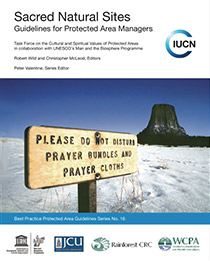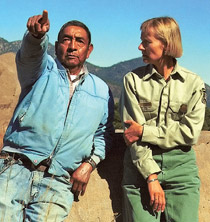Кіраўніцтва IUCN ЮНЕСКА для кіраўнікоў ахоўных раёнаў
Гэтыя рэкамендацыі ў першую чаргу дапамагаюць кіраўнікам ахоўных тэрыторый, Асабліва тыя, у каго святыя ўчасткі, размешчаныя ў межах іх юрыдычна створаных ахоўных раёнаў. Аднак яны карысныя для шырокай аўдыторыі.
Гэта было б недарэчна для МУСН або ЮНЕСКА (альбо любыя іншыя арганізацыі, якія ўмяшаюцца звонку) прадаставіць парады па кіраванні адносна святых сайтаў без дазволу і парады адпаведных захавальнікаў. Можна спадзявацца, што кіруючыя прынцыпы будуць садзейнічаць супрацоўніцтву паміж кіраўнікамі ахоўных тэрыторый і захавальнікамі святых месцаў у бок пашыранага захавання гэтых спецыяльных месцаў.
У іх цяперашняй форме, Кіраўнічыя прынцыпы адносна падрабязныя і прадпісальныя. The 44 Навучальныя пункты групуюцца ў шэсць прынцыпаў. З пункту гледжання патоку, Звычайна яны развіваюцца ад канкрэтнага і лакальнага да больш агульнага і нацыянальнага ўзроўню. Кіраўнічыя прынцыпы ўтрымліваюць 16 тэматычных даследаванняў. Кіраўнічыя прынцыпы даступныя на англійскай мове, Іспанскі, Эстонскі і рускі. Пераклады кітайцаў і японцаў вядуцца. Валанцёры выкарыстоўваюць кіруючыя прынцыпы ў ахоўных раёнах, а іншыя ў цяперашні час перакладаюць асноўныя кіруючыя прынцыпы на шмат іншых моў. Вы можаце зрабіць тое ж самае.
Кіраўнічыя прынцыпы былі распрацаваны спецыялізаванай групай IUCN па культурных і духоўных каштоўнасцях ахоўных тэрыторый і пад рэдакцыяй Роберта Уайлда і Крыстафера Маклеода пад эгідай IUCN і чалавека ЮНЕСКА і біясферай праграмы. Кіраўнічыя прынцыпы - гэта нумар 16 Серыі кіруючых прынцыпаў найлепшай практыкі, падрыхтаванай Сусветнай камісіяй МУСН на ахоўных тэрыторыях, якія рэдагаваны. Суфер. Пітэр Валянцін.
На каго прызначаны рэкамендацыі?
У той час як кіраўнікі ахоўных раёнаў - асноўная ўвага ў кіруючых прынцыпах, Можна спадзявацца, што яны будуць карысныя для больш шырокай групы зацікаўленых бакоў і палітыкаў. Такім чынам, гэты савет накіраваны на:- Кіраўнікі асобных ахоўных тэрыторый з сакральнымі прыроднымі ўчасткамі, размешчанымі альбо ў іх, альбо побач;
- Маверсы сістэм ахоўных раёнаў, якія баяцца прыродных участкаў у межах або ў сферы ўплыву іх сеткі ахоўных тэрыторый;
- Міністэрствы прыродных рэсурсаў, якія адказваюць за ахоўныя агенцтвы і сістэмы.
- Улады планавання, якія адказваюць за планаванне землекарыстання і развіццё прыродных рэсурсаў за межамі ахоўных раёнаў;
- Традыцыйныя захавальнікі, якія жадаюць узаемадзейнічаць з уладамі па навакольным асяроддзі ці ахоўнай зоне, каб павялічыць абарону сваіх святых месцаў, альбо шукаць альбо прапанаваць парады па экалагічным кіраванні;
- Няўрадавыя і іншыя агенцтвы, якія аказваюць падтрымку захавальнікам святых прыродных помнікаў;
- Іншыя захавальнікі, Урады НДА і прамысловасць, якія жадаюць падтрымаць захаванне сакральных прыродных помнікаў.
Вы можаце дапамагчы праверыць кіруючыя прынцыпы!
Мы шукаем шэраг дзяржаўных і грамадскіх ахоўных тэрыторый для праверкі і разгляду рэкамендацый альбо для ўнясення тэматычных даследаванняў. Гэтыя ахоўныя тэрыторыі могуць ахопліваць розныя геаграфічныя раёны і экасістэмы, якія прадстаўляюць шырокія розныя культуры, веравызнанні і духоўнасці, якія кіруюць сакральнымі прыроднымі месцамі.
Тэставанне рэкамендацый можна зрабіць рознымі спосабамі ў залежнасці ад вашай здольнасці прымяняць іх у працэсе кіравання. Кіраўнічыя прынцыпы могуць быць правераны ў рамках паўсядзённых мерапрыемстваў па кіраванні. Яны таксама могуць быць выкарыстаны для распрацоўкі наўмыснага працэсу, які потым рэалізуецца ў галіне альбо інтэграваны ў цыкл маніторынгу эфектыўнасці кіравання.
Агляд рэкамендацый
Кіраўнічыя прынцыпы разглядаюцца і выпрабоўваюцца, каб дапамагчы спецыялістам па ахове і захавальнікі сакральных сайтаў забяспечыць доўгатэрміновае выжыванне такіх каштоўных месцаў, асабліва тыя, якія зараз знаходзяцца ў ахоўных раёнах, а таксама з карэнных і грамадскіх сферы.
Калі вы знаходзіцеся на ахоўнай тэрыторыі (Пэнсыльванія) менеджэр, захаванне прафесійнай, захавальнік альбо апекун сакральнага прыроднага месца (SNS), супольнасці чалавек, Навуковец альбо кіраўнік, які працуе з SNS, вы можаце дапамагчы палепшыць кіруючыя прынцыпы.
Гэта агляднае апытанне заснавана на 44 "асноўныя прынцыпы" Прадстаўлена ў раздзеле 4 Выданне кіруючых прынцыпаў і спатрэбіцца прыблізна 45 хвіліны.
Унесці тэматычнае даследаванне
Зыходзячы з уласнага вопыту ці вопыту, вы можаце зрабіць унёсак у тэматычным даследаванні альбо дапамагчы нам у разглядзе і тэставанні рэкамендацый.
У цяперашні час кіруючыя прынцыпы 16 тэматычныя даследаванні, якія ілюструюць карыснасць кіруючых прынцыпаў ва ўрадавых і грамадскіх ахоўных зонах.
Каб зрабіць унёсак тэматычнага даследавання, вы можаце прытрымлівацца прыкладаў, прыведзеных у рэкамендацыях альбо звязацца з намі, калі вы зацікаўлены ў тым, каб унесці больш структураванае і складанае тэматычнае даследаванне.
У цяперашні час мы працуем над дадзенымі тэматычнага даследавання, BASETTH дазволіць захавальнікам і спецыялістам па ахове карыстацца лепшай інфармацыяй, якую, магчыма, можна зрабіць у межах адпаведных культурных пратаколаў.





